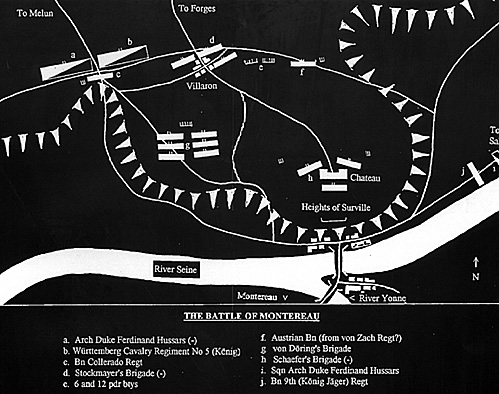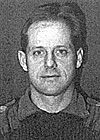Montereau 18 Feb 1814
The Sequel
Battle According To Württemberg Accounts
by Major AW Field
| |
On the evening of 16 Feb, 1814 Crown Prince Wilhelm, commanding the allied IV (Württemberg) Corps, received orders from Schwartzenberg to defend Montereau in order to cover the withdrawal of the Austrian I Corps. This corps had been isolated by its advance to Fontainbleau and Napoleon, realising its vulnerability, was lying to cut it off from the main body and destroy it. The Crown Prince had strict instructions to occupy the high ground (the Heights of Surville) overlooking Montereau and its bridges, despite the potential for disaster if he was forced to fight with a major river to his back. At daybreak on the 18th the Crown Prince received orders to hold his position until the evening. From the map of the battle in the Napoleon museum and the Württemberg account of the battle the deployment of the IV Corps can be determined more accurately than my "guesstimate" in FE45 (see map). The village of Villaron was defended by three of Stockmayer's four battalions (one battalion of the 10th (König Jäger) Regiment and both battalions of the 9th (Light Infantry) Regiment). The centre of the position was occupied by two batteries (a 12pdr and 6pdr). To their right was an Austrian battalion supported by a half battery. To the left of Villaron, astride the road to Melun, was a battalion of the Austrian Collerado Regiment covered on the extreme left by a half battery. Four squadrons of the Austrian Arch Duke Ferdinand Hussars supported these and four of the Württemberg mounted Jäger Regiment No 5 (König). The remaining three Austrian battalions of Schaefer's brigade occupied the Surville chateau and its surroundings. On each of the two forward corners of the Surville park were two guns. On the extreme right was the remaining Jäger battalion from Stockmayer's brigade, covering the road from Salins, in front of which was a single squadron of the Arch Duke Ferdinand Hussars. The reserve for the position was provided by von Döring's infantry brigade (six battalions) and a 6pdr battery which were positioned behind Villaron. Prince von Hohenlohe's infantry brigade and Jett's cavalry brigade were left on the plain to the east of Montereau to cover a withdrawal or a French outflanking move across one of the bridges further up the Seine. In total the Crown Prince had 8,500 infantry, 1,000 cavalry and 30 guns on the right bank with a farther 1,500 infantry and 1,500 cavalry on the left bank The BattleThe Crown Prince received his orders to hold until evening just as the first French attack developed at around 9 o'clock on the morning of the 18th Feb. We know from French sources that General Chateau who had only 1,500 men launched this attack. General Chateau was aware of the priority of capturing the bridge over the Seine and he therefore pressed the attack despite his inferiority of men and guns. Given this disparity it is of little surprise that he failed. The feebleness of this assault was assessed by the Württembergers as a deception attack! A more forceful assault directed against Villaron was mounted when the rest of Victor's II Corps arrived; but this too failed and General Chateau was mortally wounded. At this time there were still only 3,500 French facing the Württemberg line, not the 10,000 they claim. It was at this point that Gerard's Reserve of Paris began to arrive on the battlefield and he replaced Victor in command of H Corps. By 1230 Gerard was ready to launch the next major attack. He had been joined by Pajol's command on the Melun road and now mustered a sufficient number of men and guns to mount an assault with a more realistic chance of success. This attack was again directed against Villaron and the hard pressed Württemberg light troops who occupied the village were only able to hold on due to the timely arrival of support from von Döring's brigade. Von Döring claims to have taken a colonel, four other officers, 60 soldiers and a cannon in this counter attack. Between 2 and 3 o'clock Napoleon arrived on the battlefield with the Old Guard infantry and artillery. He immediately gave orders for a co-ordinated and well-prepared attack, which would finally overwhelm the tiring Württembergers. It was at this time too that the Crown Prince conferred with his senior commanders, von Franquemont and Stockmayer, about the prospects of withdrawing. In the face of this developing attack, all agreed that withdrawal was now the only option: the 10th (Light Infantry) Regiment was to hold Villaron to cover the withdrawal of the forward line of infantry, the cavalry and the artillery, then Schaefer's brigade were to cover the final withdrawal across the bridge. At first all went well and the move was carried out in good order but as the 10th Regiment started its withdrawal the French noticed the movement and Pajol launched his cavalry on the last remnants of this unit that were still forward. The cavalry quickly overwhelmed this rearguard and charged into the mass of the withdrawing infantry. Seeing the danger Stockmayer tried to use his brigade to try and hold them off. His suggestion to the Crown Prince that he should save himself was met with the reply; "Here I am only a general and therefore the last on the field!" Wilhelm was surrounded by heavy fighting and narrowly avoided capture having been recognised by the French cavalry. Stockmayer himself was also lucky to avoid falling into the hands of some French chasseurs à cheval: facing capture he removed the green plume that signified an Allied general, and his French style bicome and blue coat were sufficient to make the chasseurs hesitate long enough for some of his Jägers to drive them off. The Württemberg withdrawal was turned into a rout by Pajol's charge; most turned their backs on the French and raced for the bridges. Even the Württemberg account describes an "horrendous blood bath". Once across the bridge the Crown Prince ordered the 6th Regiment of Hohenlohe's brigade to attack the bridge in order to aid the escape of those who were trapped. After initial success this attack was thrown back by the heavy fire from the Guard artillery on the Heights of Surville. The withdrawal of those who made it across the bridge was covered by the charges of the Württemberg cavalry and the shattered remains of IV Corps staggered back to the village of La Tombe where contact was broken. Württemberg casualties are given as 800 dead or wounded and 2000 captured (French sources claim 3,500 captured and between 1,500 and 2,500 casualties). Whilst the majority of the former were probably Württembergers most of the latter were probably Austrians from Schaefer's brigade who provided the rearguard in the Surville chateau: we know that the Regimental Headquarters of the Collerado Regiment were taken and it is therefore quite safe to assume that many of the three battalions stationed there suffered the same fate after being cut off from the bridges by Pajol's charge. The IV Corps order of battle at the beginning of Much reflects this: neither the Austrian Collerado or von Zach infantry regiments appear although the corps was reinforced by other Austrian infantry whilst the Württemberg Jägers have been reduced to one battalion. Count Lippe, commander of the Württemberg Jägers was also captured. 
More Montereau
Battle of Montereau: Battle According To Württemberg Accounts Battle of Montereau: The Battlefield Today Battle of Montereau: The Battlefield Today More Photos (extremely slow: 452K) Back to Table of Contents -- First Empire #51 Back to First Empire List of Issues Back to MagWeb Master Magazine List © Copyright 2000 by First Empire. This article appears in MagWeb (Magazine Web) on the Internet World Wide Web. Other military history articles and gaming articles are available at http://www.magweb.com |
